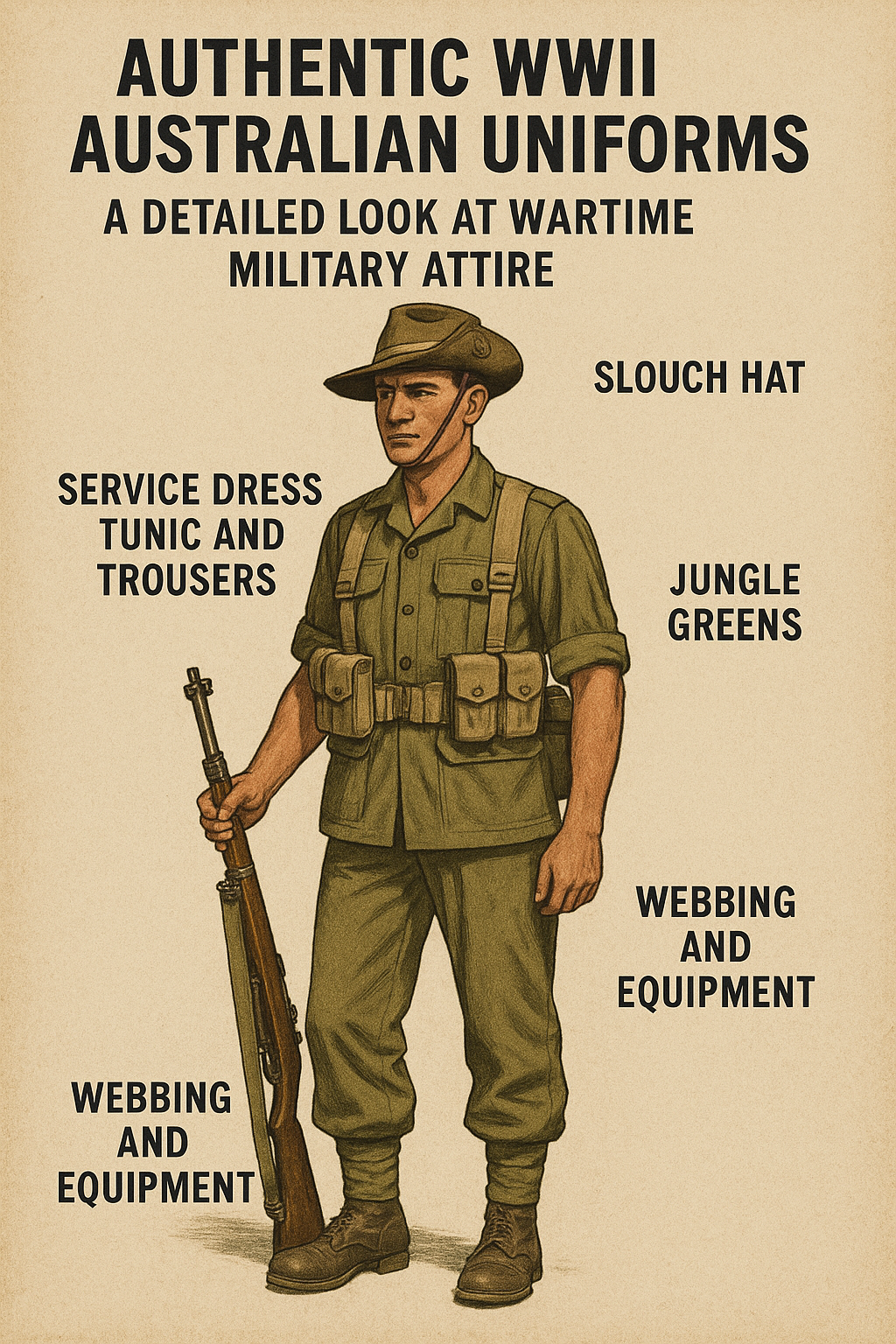
Authentic WWII Australian Uniforms: A Detailed Look at Wartime Military Attire
Published on Jun 29, 2025
WWII Australian Uniforms: A Detailed Look at Wartime Military Attire
When we talk about World War II, we often focus on battles, strategies, and heroes. But the uniforms worn by those heroes tell a story too — a story of endurance, resourcefulness, and national identity. For Australians who served in the Second World War, uniforms were more than just clothing. They symbolized unity, purpose, and adaptation under harsh conditions.
In this blog post, we’ll walk you through the essential elements of the WWII Australian uniform, why they were made the way they were, and how they evolved throughout the war. Whether you’re a collector, a history buff, or someone just fascinated by wartime fashion, this comprehensive guide is for you.
1. Historical Context: Australia’s Role in WWII
Australia entered WWII on September 3, 1939, following Britain’s declaration of war on Germany. Over 1 million Australians served during the war in various theatres — from North Africa and the Middle East to the jungles of New Guinea and the Pacific. As the terrain and climate changed, so did the uniforms. Initially based on British designs, Australian military attire evolved to meet specific needs.
2. Key Components of the WWII Australian Uniform
Let’s break down the typical uniform worn by Australian soldiers during the war:
a. Slouch Hat
Perhaps the most iconic piece of Australian military gear, the slouch hat with its upturned brim and Rising Sun badge was a proud symbol of the Aussie Digger. Originally adopted in the Boer War, it remained a staple throughout WWII.
- Made of fur felt or wool felt
- Often paired with a puggaree (cloth band around the hat)
- Designed for sun protection in harsh climates
b. Service Dress Tunic and Trousers
In the early war years, soldiers were issued Khaki wool service dress — similar to British uniforms:
- High-collared, button-up tunics
- Four front pockets
- Wool trousers tucked into puttees or gaiters
This version was more suited to European climates and often too heavy for tropical environments.
c. Jungle Greens
By 1942, as Australia shifted focus to fighting in the Pacific, a new lightweight cotton uniform called “Jungle Greens” was introduced:
- Olive drab color for camouflage
- Lighter and breathable for humid climates
- Short-sleeved shirts and shorts were often used
This was a major turning point in uniform design and gave soldiers greater mobility in tropical warfare.
3. Webbing and Equipment
Australian soldiers also carried a wide array of gear, known as webbing, which evolved over time:
- Pattern 1908 & 1937 Webbing: Adapted from British designs, featuring ammunition pouches, water bottles, and entrenching tools.
- Backpacks and Haversacks: For carrying rations, personal effects, and first aid.
- Bayonets and Helmets: Initially used the British Brodie helmet, later shifting to the Mk III.
4. Rank and Regimental Insignia
Uniforms weren’t just practical; they communicated identity and structure. Australian uniforms included:
- Shoulder patches to show unit and division
- Rank insignias sewn onto sleeves or shoulders
- Rising Sun badges for all army personnel
These symbols helped maintain order and camaraderie in the chaos of war.
5. Women's Uniforms in WWII Australia
Let’s not forget the role of Australian women. Thousands served in auxiliary roles through organizations like:
- Australian Women’s Army Service (AWAS)
- Women’s Auxiliary Australian Air Force (WAAAF)
- Australian Army Nursing Service (AANS)
Their uniforms were tailored for function and modesty:
- Skirt and blouse combinations
- Khaki or blue serge jackets
- Service caps or berets depending on the corps
These uniforms marked the growing involvement of women in Australia’s military framework.
6. Uniform Variants by Branch
Different branches of the Australian forces had variations in uniform:
Army:
- Standard jungle greens or wool dress
- Infantry and engineers had different gear loads
Royal Australian Air Force (RAAF):
- Blue-grey uniforms
- Officers wore service dress with pilot wings
Royal Australian Navy (RAN):
- Traditional sailor suits
- Bell-bottom trousers and dark blue tunics
These variations helped maintain distinction across services while ensuring practicality.
7. Collecting WWII Australian Uniforms Today
Collectors prize original WWII Australian uniforms for their historical value and craftsmanship. Here are a few things to look out for:
- Condition: Original buttons, badges, and fabric are rare
- Markings: Many uniforms are marked with service numbers or “D^D” for the Department of Defence
- Provenance: Uniforms with known service histories are especially valuable
8. How WWII Changed Military Clothing Forever
WWII was a turning point in uniform design globally. For Australia, the war triggered a shift from copying British styles to creating climate-specific, combat-ready attire. Lessons from jungle warfare and mechanized combat would influence uniform development in the Korean and Vietnam Wars as well.
Final Thoughts: A Tribute in Thread
The WWII Australian uniform is more than a relic — it’s a tribute stitched in fabric to those who fought for freedom. Every detail, from the slouch hat to the worn-out jungle greens, tells a story of grit, adaptability, and pride. Whether you’re assembling a display, participating in a reenactment, or simply honoring the past, understanding these uniforms helps keep history alive.
